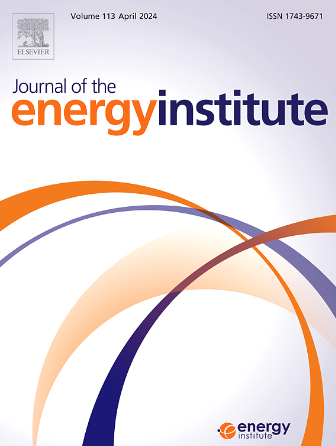Research on the impact of nitromethane on the combustion mechanism of ammonia/methanol blends
IF 5.6
2区 工程技术
Q2 ENERGY & FUELS
引用次数: 0
Abstract
Ammonia/methanol co-combustion is considered an effective liquid-liquid blending strategy to enhance the combustion performance of ammonia. However, both methanol and ammonia have high latent heats of vaporization, which necessitate significant heat absorption during the vaporization process. This often results in excessively low ambient temperatures before the ignition of the mixture, negatively affecting low-temperature ignition and combustion. To improve the combustion characteristics of ammonia/methanol blends, this study proposes the addition of nitromethane, forming a ternary blend of ammonia/methanol/nitromethane to enhance fuel performance. To evaluate the impact of nitromethane on the combustion mechanism of ammonia/methanol blends, this study utilizes synchronous vacuum ultraviolet photoionization mass spectrometry to analyze the oxidation reactions of the ammonia/methanol/nitromethane blends. Based on the Brequigny model, cross-reactions involving C-N bonds and reactions related to nitromethane were incorporated for model modification, resulting in the newly modified model, termed A-M. Pathway and sensitivity analyses, as well as ignition delay time simulations, were conducted to further understand the combustion process. The results indicate that the addition of nitromethane to the ammonia/methanol blend lowers the initial reaction temperature from 860 K to 740 K and increases nitrogen oxide (NOx) concentrations at 1050 K. At 800 K, nitromethane reduces the conversion of NH2 to NH3, thereby enhancing ammonia consumption and altering the NOx consumption pathway. Furthermore, at 1020 K, 98.6 % of H2NO reacts with H to form NH2, which is a crucial species in ammonia regeneration. Additionally, at 1020 K, 90.8 % of nitromethane decomposes through the reaction CH3NO2(+M) = CH3 + NO2(+M), contributing to increased NOx emissions. Moreover, the incorporation of nitromethane significantly reduces the ignition delay time of ammonia/methanol blends, demonstrating its potential to improve the overall combustion performance of these mixtures.
硝基甲烷对氨/甲醇混合物燃烧机理的影响研究
氨/甲醇共燃被认为是一种有效的液-液混合策略,可提高氨的燃烧性能。然而,甲醇和氨的汽化潜热都很高,因此在汽化过程中必须大量吸热。这通常会导致混合物点火前的环境温度过低,从而对低温点火和燃烧产生不利影响。为改善氨/甲醇混合物的燃烧特性,本研究提出添加硝基甲烷,形成氨/甲醇/硝基甲烷三元混合物,以提高燃料性能。为了评估硝基甲烷对氨/甲醇混合物燃烧机理的影响,本研究利用同步真空紫外光离子化质谱仪分析了氨/甲醇/硝基甲烷混合物的氧化反应。在布雷基尼模型的基础上,加入了涉及 C-N 键的交叉反应和与硝基甲烷有关的反应,对模型进行了修改,从而得到了新修改的模型,称为 A-M。为进一步了解燃烧过程,进行了路径和敏感性分析以及点火延迟时间模拟。结果表明,在氨/甲醇混合物中加入硝基甲烷可将初始反应温度从 860 K 降低到 740 K,并增加 1050 K 时的氮氧化物(NOx)浓度。此外,在 1020 K 时,98.6% 的 H2NO 与 H 反应生成 NH2,而 NH2 是氨再生过程中的关键物种。此外,在 1020 K 时,90.8% 的硝基甲烷通过反应 CH3NO2(+M) = CH3 + NO2(+M) 分解,导致氮氧化物排放量增加。此外,硝基甲烷的加入大大缩短了氨/甲醇混合物的点火延迟时间,证明了其改善这些混合物整体燃烧性能的潜力。
本文章由计算机程序翻译,如有差异,请以英文原文为准。
求助全文
约1分钟内获得全文
求助全文
来源期刊

Journal of The Energy Institute
工程技术-能源与燃料
CiteScore
10.60
自引率
5.30%
发文量
166
审稿时长
16 days
期刊介绍:
The Journal of the Energy Institute provides peer reviewed coverage of original high quality research on energy, engineering and technology.The coverage is broad and the main areas of interest include:
Combustion engineering and associated technologies; process heating; power generation; engines and propulsion; emissions and environmental pollution control; clean coal technologies; carbon abatement technologies
Emissions and environmental pollution control; safety and hazards;
Clean coal technologies; carbon abatement technologies, including carbon capture and storage, CCS;
Petroleum engineering and fuel quality, including storage and transport
Alternative energy sources; biomass utilisation and biomass conversion technologies; energy from waste, incineration and recycling
Energy conversion, energy recovery and energy efficiency; space heating, fuel cells, heat pumps and cooling systems
Energy storage
The journal''s coverage reflects changes in energy technology that result from the transition to more efficient energy production and end use together with reduced carbon emission.
 求助内容:
求助内容: 应助结果提醒方式:
应助结果提醒方式:


